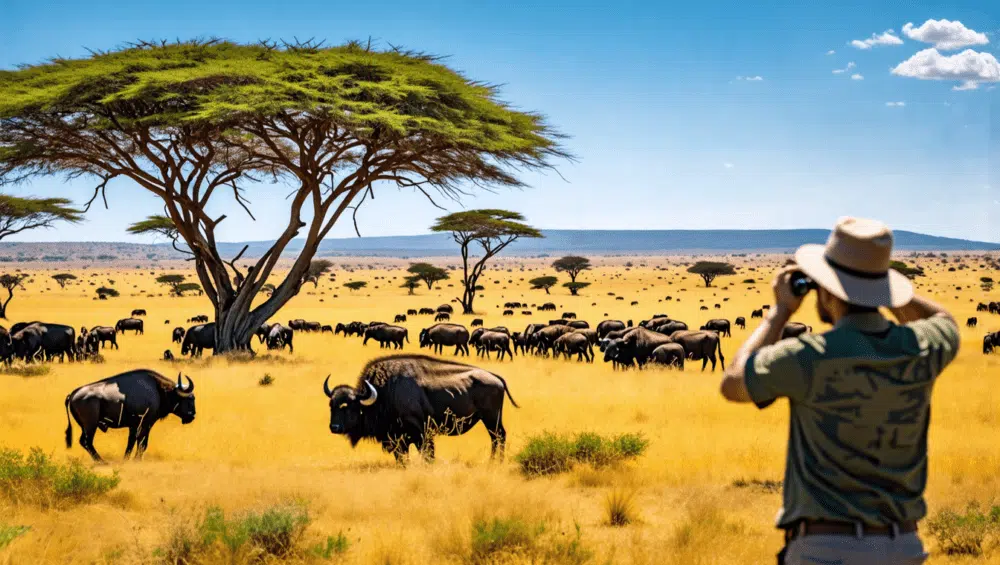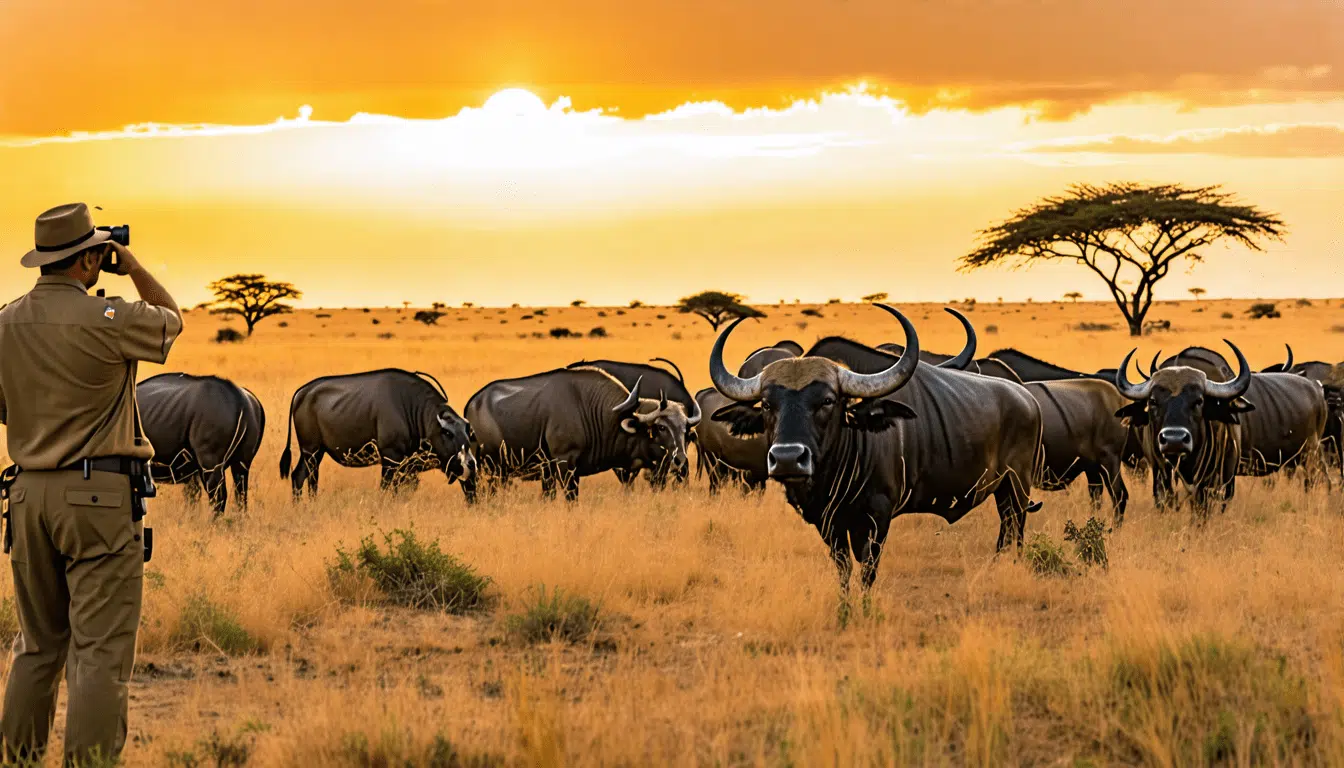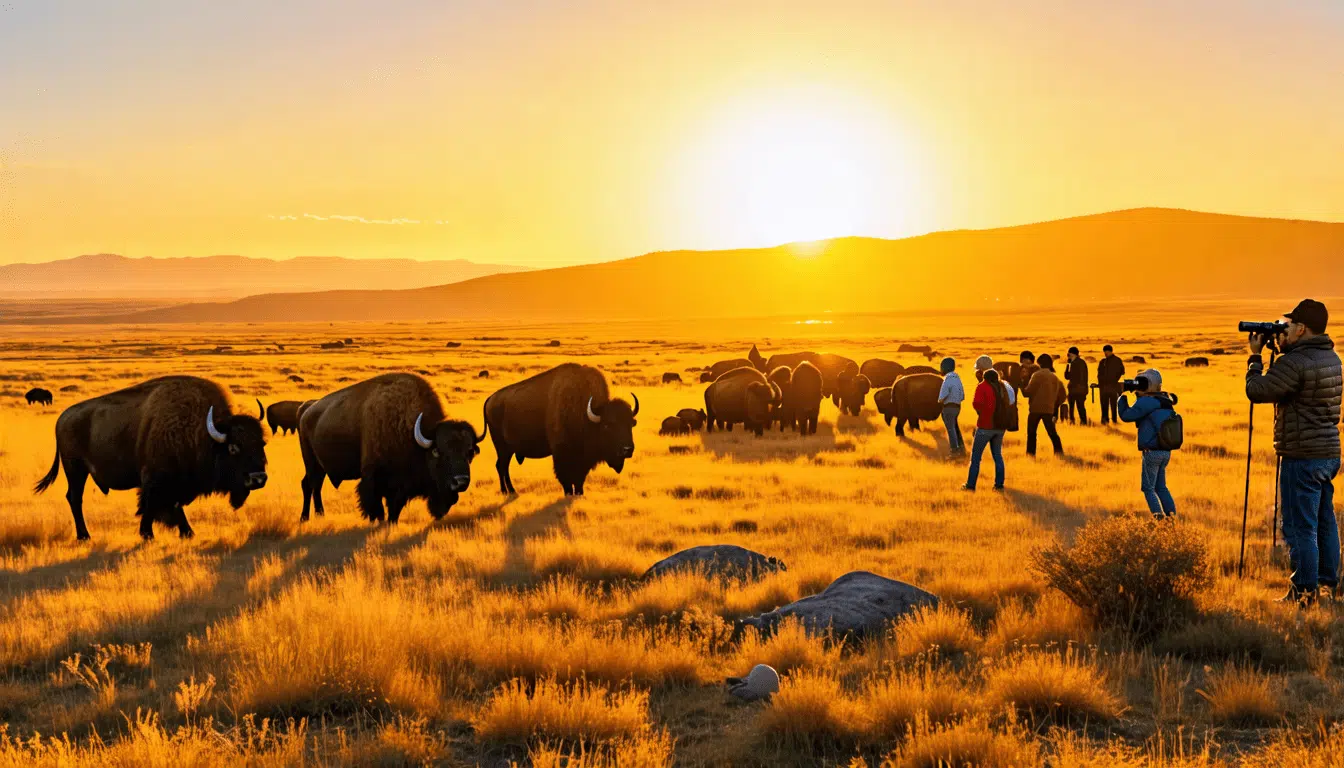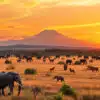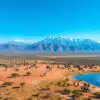Introduction to Buffalo Watching in East Africa
You know that exhilarating feeling when you’re standing amidst the vast African savannah, the sun setting in a dramatic blaze of orange while a herd of stately African buffalo meanders across the plains? If you haven’t experienced it yet, adding East Africa to your bucket list might just be the best decision you make this year. Imagine being a wildlife enthusiast, captivated by the sheer diversity and grandeur of nature’s creations. East Africa, with its breath-taking landscapes and rich biodiversity, stands as a veritable paradise for anyone with a penchant for wildlife adventures.
Let’s talk African buffalo. These majestic creatures, often spotted in the thousands, are the unsung heroes of the savannah. Sure, everyone raves about the Big Five, and the buffalo is proudly among them, but have you ever truly appreciated the wild allure of these powerful beasts in their natural habitat? The thrill of observing them in East Africa, striding across the plains with their imposing stature, is an experience worth every bit of hype.
But where exactly do you go to marvel at these incredible animals? East Africa boasts several key areas renowned for their high buffalo populations, where the promise of an unforgettable buffalo-watching experience is as real as the buffalo themselves. Places like Serengeti National Park and Maasai Mara National Reserve offer dramatic landscapes teeming with wildlife, while the Ngorongoro Crater provides a unique environment that supports a vibrant buffalo society.
So, pack your safari gear, bring along that trusty pair of binoculars, and prepare yourself for a buffalo-watching adventure like no other. Let’s dive deeper into the top locations where you can witness these remarkable creatures in action.
Introduction to Buffalo Watching in East Africa
If you’re a wildlife enthusiast or even just someone who can’t resist the allure of the wild, East Africa undoubtedly calls your name. Why? It’s simple. East Africa is one of those regions where nature appears to have been let loose, in the best way imaginable. Rolling savannahs, sprawling landscapes, and yes, the thrill of spotting African buffalo in their natural habitat—all contribute to making this area a prime destination for adventurers. It’s like nature’s own theater, and you’re invited to watch the show.
Now, let’s talk about buffalo. Not just any buffalo, but the African buffalo. It’s not called one of the Big Five for nothing. Aside from their impressive horn spread, these creatures embody the wilderness. Imagine standing in an open Jeep, the wind in your hair, as you observe a herd of hundreds of buffalo trudging across the plains. It’s akin to stepping into a nature documentary, only this time, you’re behind the camera—or iPhone, let’s be real.
The Importance and Thrill of Spotting Buffalo
There’s something electrifying about the act of spotting buffalo that goes beyond their majestic appearance. Perhaps it’s their unpredictable nature or their sheer strength. These cattle-like beasts may appear laid back while grazing, but provoke one, and you’ve got yourself a tale of survival—and hopefully, a safe exit strategy, thick skin does have its perks, after all.
Why should you consider making an effort to see buffalo in East Africa? Apart from ticking off a big species from your must-see list, it’s about understanding the delicate balance of nature. When you see a herd of buffalo interacting—nursing calves, defending territory, foraging for food—you gain insight into the ecosystem’s complexity. It’s a lesson in ecology that textbooks can’t quite capture.
Key Areas for High Buffalo Populations
East Africa isn’t just some random stamp on the map for those eager to see buffalo. Specific regions boast high buffalo populations, creating prime viewing opportunities that rival the scenes in any movie. But where exactly should you plant yourself for this grand experience?
For starters, let’s briefly navigate some of the hotspots. The vast Serengeti National Park in Tanzania is often the poster child for wildlife exploration, and for a good reason—it’s home to large buffalo herds that roam its endless plains. Remember seeing those stunning safari photos of buffalo backlit by the setting sun? Yeah, chances are they were from here.
Next, the Maasai Mara National Reserve in Kenya needs no introduction. Famous for the Great Migration, where millions of wildebeests and zebras embark on a journey, buffalo often while away their days, grunting and grazing, in this iconic setting. The juxtaposition of calm buffalo and chaotic migrations is a spectacle in and of itself.
Then there’s the enchanting Ngorongoro Crater in Tanzania. Known for its unparalleled ecosystems, the crater offers a concentrated area where buffalo thrive without needing to venture far for resources. So many buffalo, so little time. It’s like nature’s little cheat sheet for wildlife watching.
Of course, these are just teasers for what you can experience. Each park and reserve in this region showcases a unique slice of buffalo life, making every visit distinct. Ever consider how wide the smile on your face might grow when you’re surrounded by these magnificent creatures? I bet it’s wider than that. And while the view itself is a prize, the stories you take home are the real treasure.
In East Africa, buffalo watching isn’t merely about observing wildlife; it’s about connecting with a land largely untouched, a land that reveals the raw essence of nature. So, why wait? The plains are calling. Are you ready to answer?
Top National Parks and Reserves for Buffalo Sightings
When it comes to buffalo sightings, East Africa is nothing short of spectacular. These majestic creatures, often seen as the unsung heroes of the savannah, are most prolific in some of the continent’s most renowned national parks and reserves. Imagine standing on the sun-baked plains, feeling the anticipation in the air. The ground vibrates softly underfoot as a massive herd of buffalo gradually emerges from the shimmering horizon like a moving sea of brown and black. Intrigued? Let me take you on a journey through some of the best spots to witness these amazing animals.
Serengeti National Park, Tanzania
The Serengeti National Park is synonymous with wildlife adventure. Covering approximately 15,000 square kilometers (roughly 5,800 square miles) of vast open plains, it’s a premier destination for any safari enthusiast. I’ll never forget my first trip to the Serengeti—waking up to the distant roars of lions and seeing the wide, unhindered stretches of land ready to be explored. This park is home to a plethora of predators and prey alike, but if you’re here for the buffalo, you’re in for a treat.
The best times to see buffalo in the Serengeti are typically during the dry season, from June to October. During these months, the grass is shorter, making it easier to spot the large herds. As the dust rises with each step of the herd and the iconic acacia trees stand sentinel, you’ll find yourself lost in the moment as you watch hundreds of buffalo graze peacefully under the African sun.
Maasai Mara National Reserve, Kenya
The Maasai Mara National Reserve in Kenya is another heavyweight contender for your buffalo viewing pleasure. Known worldwide for the Great Migration, the Maasai Mara offers an unparalleled spectacle as millions of wildebeest, zebras, and yes, buffalo move in search of greener pastures. Once, standing on the reserve’s sweeping plains, I was taken aback by the sheer magnitude of life present before me. It was a real-life scene straight out of a nature documentary.
For buffalo devotees, visiting during the timing of the Great Migration—which generally peaks in the Maasai Mara between July and October—means witnessing interaction between the buffalo and other members of the cast of critters. This experience provides a unique backdrop for observing the behavioral dynamics within the herds and their interactions with predators such as lions and hyenas. You’ll gain insights into how these creatures survive amidst such overwhelming numbers.
Ngorongoro Crater, Tanzania
Imagine looking at a landscape so perfect it seems almost unreal. That’s the Ngorongoro Crater for you. It’s a UNESCO World Heritage Site and the result of a colossal volcanic explosion that took place millions of years ago. The crater is now a thriving and self-contained ecosystem, making it a fantastic habitat for buffalo and a myriad of other species. Driving down into it for the first time gave me goosebumps—like entering a hidden kingdom untouched by time.
The crater’s floor is teeming with life and supports a significant buffalo population. Buffalo are often seen grazing the grasslands, and the unique topography of the crater makes it easier to spot them and other animals. They are especially visible during the dry season between June and October, when water sources become focal meeting points for wildlife. You’ll be amazed by the dark, hulking forms of buffalo against the backdrop of the lush crater scenery.
Each of these parks and reserves not only holds the promise of incredible buffalo sightings but also provides a deep connection to the wild, untouched beauty of East Africa. Whether you’re into the thrill of the chase in the Serengeti, the dynamic drama of the Maasai Mara, or the enchanting allure of Ngorongoro, rest assured, your buffalo expedition will grant memories you’ll cherish for a lifetime. So, when are you scheduling your visit?
Buffalo Conservation Efforts in East Africa
Have you ever stood in the grasslands of East Africa, binoculars in hand, scanning the horizon for the telltale silhouette of a buffalo herd? It’s a breathtaking experience, yet one deeply intertwined with ongoing conservation efforts. You see, spotting a buffalo isn’t just about luck—it’s also about the behind-the-scenes work of dedicated conservationists who strive to keep these mighty creatures roaming freely.
The Importance of Buffalo Conservation Initiatives
Buffalo are a cornerstone species in the African savannah, not just because they’re majestic, but because they play a crucial role in the ecosystem. They help maintain the grasslands, which in turn supports a variety of wildlife. Maintaining healthy buffalo populations means safeguarding this delicate balance. But how do conservationists do this?
Picture this: A bustling community in Tanzania, teeming with people who share their land with these magnificent creatures. Conservation initiatives often start here, with community involvement at their heart. Why? Because locals hold the key to successful wildlife protection. Programs that promote eco-tourism, provide education, and offer alternative livelihoods have been instrumental in supporting buffalo populations.
Successful Programs and Community Involvement
One standout effort is the African Wildlife Foundation’s (AWF) work in Kenya and Tanzania. AWF has initiated projects that involve local communities, not only raising awareness about buffalo and other wildlife but also training locals in conservation practices. For instance, did you know that many safari guides are local, trained by such programs? By becoming advocates for wildlife, they help tourists, like you and me, appreciate these magnificent animals even more.
Then there are financial incentives tied to conservation. Community-based projects often include profit-sharing schemes tied to eco-tourism. When locals see tangible benefits from protecting wildlife, they’re more likely to support conservation efforts. It’s a win-win—communities thrive, and so does the buffalo population.
Challenges and Ongoing Efforts
Of course, where there’s wildlife, there are challenges. Poaching and habitat loss remain significant threats to buffalo across East Africa. Poachers target these creatures for their hides and horns, while expanding agriculture shrinks their habitat. Faced with such obstacles, what’s a conservationist to do?
Enter anti-poaching patrols and land management initiatives. Organizations work tirelessly to implement these measures, often utilizing technology like drones to monitor buffalo herds’ movements and ensure their safety. It’s like something out of a high-tech spy movie, don’t you think? Yet, it’s the reality of modern conservation.
Confronted with habitat loss, conservationists also push for the creation and expansion of protected areas. Initiatives aim to restore natural habitats by working with governments to designate national parks and reserves where buffalo can roam—not unlike those vast plains you imagined at the start of all this, teeming with life.
Takeaway: More Than Just a Spectacle
So, the next time you’re in East Africa, gazing at a herd of buffalo, remember: Behind this incredible sight is a tapestry of conservation efforts, community involvement, and relentless dedication. It’s a reminder that while our safaris may last a moment, the work to ensure future generations can enjoy the same experiences continues every day. How’s that for a conversation starter at your next dinner party?
Planning Your Buffalo Viewing Experience
So, you’ve decided to embark on a buffalo-watching adventure in East Africa? Fantastic choice! Let me walk you through some steps to ensure you have the best experience possible—without any buffalo-related mishaps, of course.
Best Times of the Year for Buffalo Sightings
Timing is everything, right? When it comes to buffalo watching, it couldn’t be truer. The peak time for buffalo sightings varies slightly depending on where you’re headed in East Africa.
In Tanzania’s Serengeti National Park, the dry season from June to October is prime time. During these months, water sources become scarce, and you’ll often find these majestic creatures congregating near rivers and waterholes. Sounds like a scene straight out of a nature documentary, doesn’t it?
Meanwhile, over in Kenya’s Maasai Mara, you can enjoy buffalo sightings year-round. However, visiting between July and October allows you to combine this with the Great Migration—a phenomenon that’s as impressive as it sounds.
In Ngorongoro Crater, buffalo herds thrive due to the crater’s constant water supply. Any time of year is a good time here, although visiting in the dry months can facilitate easier wildlife spotting amid the sparse vegetation.
Recommended Safari Operators and Tours
Alright, let’s talk safari operators. Picking the right one is like choosing the perfect travel buddy—crucial for a great trip. A few renowned operators specialize in buffalo-watching tours and promise an experience that stands a cut above the rest.
In Tanzania, companies like Serengeti Safari Tours and Kilimanjaro Explorers come highly recommended. They offer extensive packages that include expert guides who know all the best buffalo hotspots like the back of their hands. Trust me, you want someone who can answer the question: Why are those buffalos eyeballing us?
In Kenya, GoWild Safaris and Maasai Mara Adventures have built solid reputations for personalized safari experiences. They’ll turn your buffalo-spotting mission into a memorable tale you’ll be recounting at dinner parties for years.
Tips for a Safe and Environmentally-Responsible Safari Experience
Let’s get real for a second: enjoying wildlife doesn’t mean we have to disturb it. Here are some tips to ensure your safari is safe and eco-friendly.
First off, keeping a respectful distance is key. Buffalo may appear slow, but they can be surprisingly swift when annoyed. Stay in the vehicle unless your guide suggests otherwise. And speaking of your guide—consider them your safari guru and follow their instructions diligently.
Ever hear the saying, Leave nothing but footprints? It’s a mantra on safaris. Carry out all trash, and resist the urge to collect souvenirs from wildlife habitats. Let’s leave nature untouched for the next traveler, shall we?
When it comes to cultural sensitivities, remember you’re a guest. Engage with local communities respectfully, appreciate their way of life, and support community-based tourism initiatives. Buying local crafts and products can significantly benefit these communities economically, making your trip impactful in more ways than one.
By considering these tips, you’re not just planning a trip—you’re planning an unforgettable, responsible buffalo-watching adventure. Get ready to witness the majesty of buffalos in their natural East African paradise! So, what’s holding you back? Pack those binoculars and get ready for the adventure of a lifetime!
Conclusion
So there we have it, a journey through the open plains and majestic reserves, meeting some of East Africa’s most formidable inhabitants—the African buffalo. I don’t know about you, but I’m already packing binoculars for my next safari. Who wouldn’t want to witness these magnificent creatures in places like the Serengeti or Maasai Mara? The thrill of seeing them roam free, fiercely protective yet surprisingly peaceful, is something every wildlife enthusiast should experience.
It’s clear that East Africa is not just a haven for wildlife watchers; it’s a testament to successful conservation efforts that continue to safeguard the buffalo’s future. With community involvement and relentless dedication from conservationists, the buffalo’s mighty herds remain a living reminder of the urgent need to protect our natural world. While challenges like poaching and habitat loss persist, so does the fight to overcome them.
If you’re gearing up to join this wild adventure, timing is everything. Plan your journey wisely, choosing the right season to maximize your buffalo sightings. And remember, it’s not just about the photo ops. Engage with local guides, respect the land and its people, and lend your support to eco-friendly initiatives. After all, a safari isn’t just about what you take home in snapshots, but also about what you leave behind—a positive impact on the places and creatures that host you.
So, ready to dust off that safari hat and immerse yourself in the wilds of East Africa? The buffalo await, and their story continues with every visitor who steps into their world with curiosity and respect. Happy exploring!

